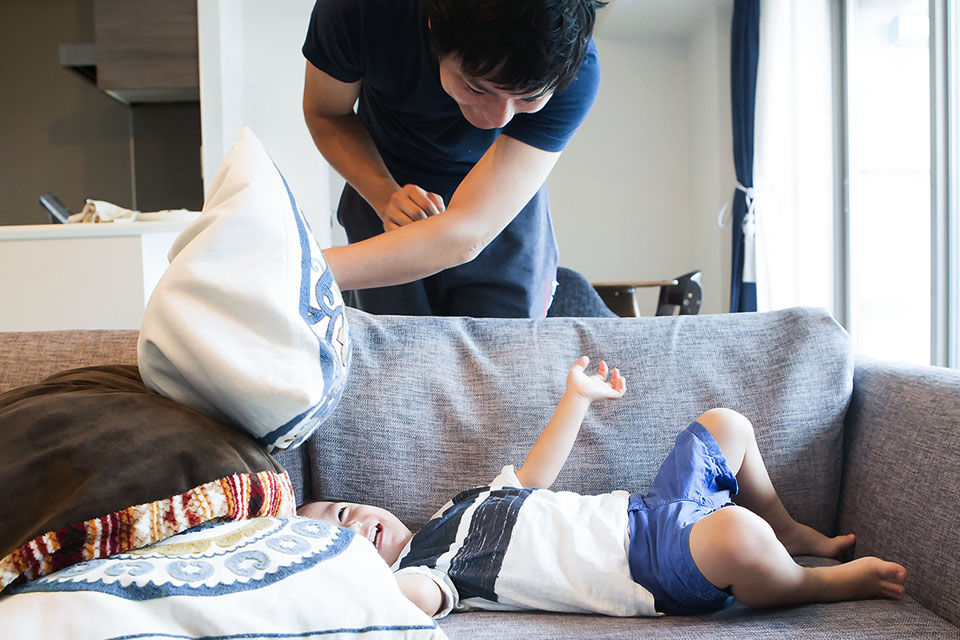Danone Specialized Nutrition (Malaysia) Sdn Bhd supports exclusive breastfeeding for your infant’s first six months of life. After six months of age, infants should receive age-appropriate complementary foods while breastfeeding continues for up to two years of age or beyond. Consult your doctor before deciding to use infant formula or if you have difficulty breastfeeding.
5 Tips To Play with Your Child At Home
Days could be long, during lockdown. Playing games is critical to developing a child’s imagination. Limit screen time with the countless fun games that siblings can play together.
For the safety of children, and to witness all the fun, make sure you supervise their play. And don’t forget, most importantly to wash your and their hands before and after playing. Avoid any face contacts with the hands as much as possible!

Camping at Home
- Go on a camping trip at home. Let them make a mess while enjoying stay-at-home adventures!
- Supply them with a tent and let them make one (think sheets, tables, chairs, etc.) Make sure that you supervise children as they set up their tent.
- Once the tent is set up, have them fill it with sleeping bags, cushions, blankets and/or pillows.
- Help them round up items such as flashlights, snacks and drinks, books, stuffed animals and games. A deck of cards and a board game will keep the children entertained for hours.
- Other items to put in your play tent include a small table and chairs, coloring books and crayons, building blocks and Play-Dough.
- Leave the rest to their imagination!
Hide-and-Seek
- Hide-and-seek is a children’s favourite!
- Choose one player who will close his or her eyes for a brief period (often counting out loud to 20) while the other players hide.
- Define a safe space in which the children can hide, set boundaries of places where they should not go for safety (eg: stairs) or other reason (eg: the room where parents are trying to get some work done from remote!).
- The seeker then opens his or her eyes and tries to find the hiders; the first one found is the next seeker, and the last one found is the winner of the round.
- In one of many forms of the game, the hiders try to run back to “home base” while the seeker is away looking for them; if all of the hiders return safely, the seeker repeats as seeker in the next round.


Hot and Cold
- Hot and Cold has been a children’s favorite for years. The only things needed are two or more players and an object or a prize.
- Start by choosing a “hunter” and have them leave the room.
- Hide a small object or prize somewhere in the space where you are playing. Then bring the hunter back and have them look for the object.
- Signal to the hunter that they are moving away from the hidden object by saying “colder.” If they keep moving in the wrong direction, use words that indicate degrees of cold, such as “freezing” or “icy.”
- Tell the hunter that they are getting closer to the hidden object by saying “hotter.” As they move closer, say “burning” or “scorching.”
- Continue giving clues until the hunter finds the hidden object.
- You can also play this game by clapping your hands, faster as the hunter gets closer and more slowly as the hunter gets further away from the object or prize.
Guess the Object
- Children will need to use their best observation and detective skills to identify the mystery object in this guessing-game activity.
- Start by having the first player think of an object that they can see around them. Ask them to whisper the object to you and then write it down on a piece of paper.
- The other player(s) tries to guess the object by asking questions that can only answered with a “yes” or a “no”. For example, if the object is a picture frame, a player might ask “Does it have a picture frame, a player might ask “Does it have a glass?” or “Is it made of wood?”
- Up to 20 questions can be asked. If the players have not guessed the answer in 20 questions, each player gets one last chance to make a guess of the object.


Name, Animal, Plant, City
- Create a 5-column table for each player. Name them: NAME, ANIMAL, PLANT, CITY, and finally SCORE.
- You can change the categories according to the children’s ages. a) Going clockwise for each turn, one player begins by reciting the alphabet until the next player says “STOP”. Depending on which letter the first player stops at, all players must then fill in the columns with a word starting with that letter.
Here is an example for the letter A
Name: Adam
Animal: Ant
Plant: Acacia
City: Amsterdam
b) For each correct answer, players receive 10 points. If the players get a common answer, each is rewarded 5 points. If an answer is not accepted by all players (e.g. if the name of the answer does not exist) or if the answer is blank, the player gets 0 points
c) The second round starts with the second player and proceeds exactly as the first round did.
d) At the end of the game, the player with the most points wins!
e) You can always act as moderator here, helping to total points.

Connect with our team of experts
We provide advice and support for you on your parenthood journey.

